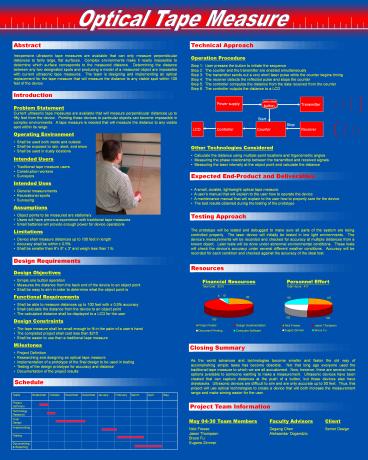Optical Tape Measure - PowerPoint PPT Presentation
1 / 1
Title:
Optical Tape Measure
Description:
Complex environments make it nearly impossible to determine which surface ... Eugene Zimmer. Faculty Advisors. Degang Chen. Aleksandar Dogandzic. Client. Senior Design ... – PowerPoint PPT presentation
Number of Views:92
Avg rating:3.0/5.0
Title: Optical Tape Measure
1
Optical Tape Measure
Abstract
Technical Approach
Inexpensive ultrasonic tape measures are
available that can only measure perpendicular
distances to fairly large, flat surfaces.
Complex environments make it nearly impossible to
determine which surface corresponds to the
measured distance. Determining the distance
between any two designated spots and producing a
model of a measured object are impossible with
current ultrasonic tape measures. The team is
designing and implementing an optical replacement
for the tape measure that will measure the
distance to any visible spot within 100 feet of
the device.
- Operation Procedure
- Step 1 User presses the button to initiate the
sequence - Step 2 The counter and the transmitter are
enabled simultaneously - Step 3 The transmitter sends out a very short
laser pulse while the counter begins timing - Step 4 The receiver detects the reflected pulse
and stops the counter - Step 5 The controller computes the distance
from the data received from the counter - Step 6 The controller outputs the distance to a
LCD - Other Technologies Considered
- Calculate the distance using multiple point
locations and trigonometric angles - Measuring the phase relationship between the
transmitted and received signals - Measuring the laser intensity at the object
point and calculate the distance
Introduction
Power supply
Transmitter
button
- Problem Statement
- Current ultrasonic tape measures are available
that will measure perpendicular distances up to
fifty feet from the device. Pointing these
devices to particular objects can become
impossible in complex environments. A tape
measure is needed that will measure the distance
to any visible spot within its range. - Operating Environment
- Shall be used both inside and outside
- Shall be exposed to rain, sleet, and snow
- Shall be used in dusty locations
- Intended Users
- Traditional tape measure users
- Construction workers
- Surveyors
- Intended Uses
- General measurements
- Recreational sports
- Surveying
- Assumptions
- Object points to be measured are stationary
- Users will have previous experience with
traditional tape measures - Small batteries will provide enough power for
device operations - Limitations
Start
Counter
Receiver
Controller
LCD
Stop
Expected End-Product and Deliverables
- A small, durable, lightweight optical tape
measure - A users manual that will explain to the user
how to operate the device - A maintenance manual that will explain to the
user how to properly care for the device - The test results obtained during the testing of
the prototype
Testing Approach
The prototype will be tested and debugged to make
sure all parts of the system are being controlled
properly. The laser device will initially be
tested in low light environments. The devices
measurements will be recorded and checked for
accuracy at multiple distances from a known
object. Later tests will be done under abnormal
environmental conditions. These tests will check
the devices accuracy under several different
weather conditions. Accuracy will be recorded
for each condition and checked against the
accuracy of the ideal test.
Design Requirements
Resources
- Design Objectives
- Simple one button operation
- Measures the distance from the back end of the
device to an object point - Shall be easy to aim in order to determine what
the object point is - Functional Requirements
- Shall be able to measure distances up to 100
feet with 0.5 accuracy - Shall calculate the distance from the device to
an object point - The calculated distance shall be displayed to a
LCD for the user - Design Constraints
- The tape measure shall be small enough to fit
in the palm of a users hand - The completed project shall cost less than 215
- Shall be easier to use than a traditional tape
measure - Milestones
- Project Definition
- Researching and designing an optical tape
measure - Implementation of a prototype of the final
design to be used in testing - Testing of the design prototype for accuracy
and distance - Documentation of the project results
Financial Resources Total Cost 215
Personnel Effort Total Hours 417
Closing Summary
As the world advances and technologies become
smaller and faster the old way of accomplishing
simple tasks has become obsolete. Not that long
ago everyone used the traditional tape measure to
which we are all accustomed. Now, however, there
are several more options available to someone
wanting to make a measurement. Ultrasonic
devices have been created that can capture
distances at the push of a button, but these
devices also have drawbacks. Ultrasonic devices
are difficult to aim and are only accurate up to
50 feet. Thus, this project will use optical
technologies to create a device that will both
increase the measurement range and make aiming
easier for the user.
Schedule
Tasks September October November December January February March April May
Project Definition
Technology Research
Final Design
Implementing
Testing
Documenting Reporting
Project Team Information
May 04-30 Team Members Nick Freese Jason
Thompson Bruce Fu Eugene Zimmer
Faculty Advisors Degang Chen Aleksandar Dogandzic
Client Senior Design































